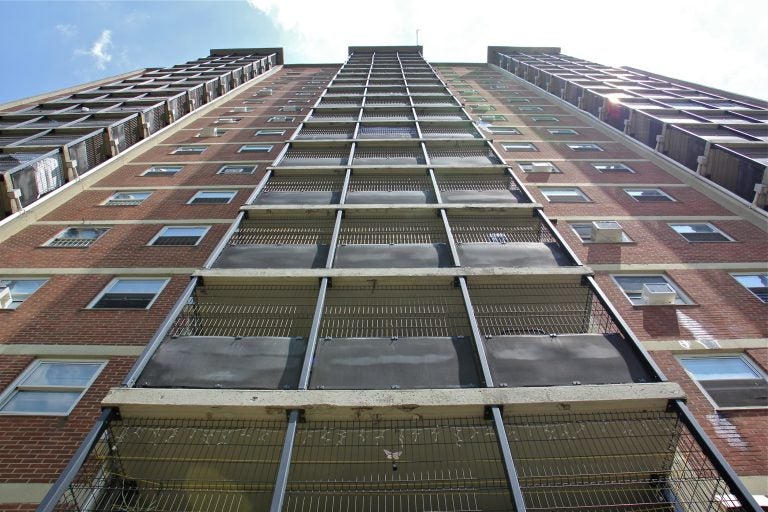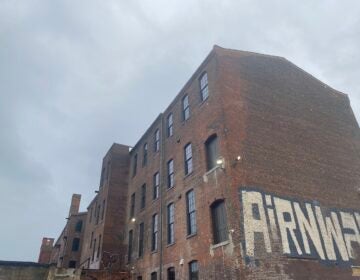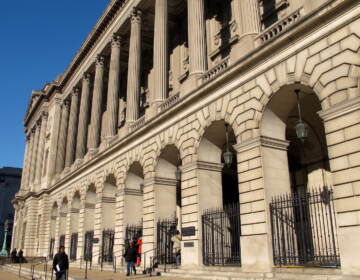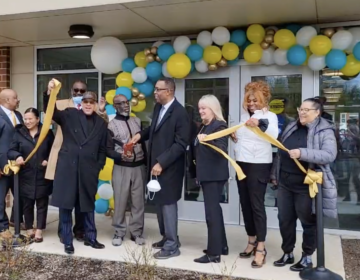Philadelphia Housing Authority moves to demolish one of its last surviving towers
One of Philly’s last surviving public housing towers is moving towards demolition. Many tenants say the time is right.

Fairhill apartments in North Philadelphia. (Emma Lee/WHYY)
This article originally appeared on PlanPhilly.
—
Shirley Reynolds and her neighbors’ homes may soon be destroyed, and she’s delighted.
“I’m happy,” said Shirley Reynolds, a retired construction worker.
Reynolds’ Fairhill apartment is on the third floor of one of the Philadelphia Housing Authority’s last remaining high-rise buildings. She is ready to see it go.
“It needs to be done,” Reynolds said.
Decades after the cash-strapped housing authority began imploding aging towers like Reynolds’ building, PHA is finalizing a plan to redevelop the 56-year-old Fairhill Apartments complex. The agency expects to submit an application to redevelop the property to federal housing officials by the end of the month, the authority’s president and CEO Kelvin Jeremiah said in an interview Wednesday.
The development’s 264 units, split between two high-rises and seven low-rise buildings, will be replaced by Section 8 housing owned by PHA. One of the towers will be demolished while the other will remain as senior housing. New low-rise family housing will be spread throughout the 4.5-acre housing authority site and surrounding neighborhood, creating a mix of homeowners and renters.
“I’m looking very forward to them bringing it down,” said Valerie Russ, Reynold’s third floor neighbor. “It’s much needed.”
Complaints of filth, fires and squatters
Tenant complaints include filthy elevators that malfunction often and squatters who mosey past the building’s security guards.
“People got kids that got to go to school,” Russ said. “You don’t know if these people are sexual predators or not.”
“You hear the rats or whatever crawling through these damn walls,” said Reynolds, who cleans her apartment with peppermint oil to keep the restless vermin under control.
“I’m scared they’re going to come in my apartment,” she said. “Whatever the fuck is in the walls I don’t want in my apartment.”
Then there’s the arson.
“As soon as they see a chance to ignite something, here they go,” Russ said.
The Philadelphia Fire Department has responded to eight reported fires at the Fairhill complex since 2017, according to the city agency. Two of those were indoor trash fires.
And when there isn’t a fire, the alarm system randomly sounds. It’s confusing, Reynolds said.
“I just go to the balcony and I look,” Reynolds said. “I don’t smell nothing. I be like ‘Oh, it ain’t no fire. It’s just the damn alarm thing again.’ So, I don’t know when it is a fire or when it ain’t a fire.”
Fairhill requires nearly $31 million in urgent repairs that must be done over the next five years, according to PHA documents. That equals more than $110,000 per unit. The needs include repairs to the fire alarm, elevator and sewer systems, and the roof.
Looking out over the next 20 years, repair costs jumped to more than $81 million, equating to more than $300,000 per unit. And that excludes upgrades for residents such as modernized bathrooms and kitchens.
As of last year Fairhill operated at a $1 million-plus deficit due to insufficient rent and federal funding.
PHA officials met with residents and offered a choice to remake the development or leave operations as they are. Residents voted for the latter.
When the Fairhill redevelopment is complete, there will be 12 PHA towers left across the city, down from 36 that operated through the 1990s when PHA began converting mid-century highrises into lower-density development.
Over that same period, the number of housing units shrank as well. Most of the tall buildings that remain have undergone conversions into senior housing.
One of other tower developments to survive, Westpark Apartments, made national headlines last week when a fire broke in a 19-story building and a man named Jermaine scaled 15 floors of enclosed balconies to alert his bedridden mother of the blaze.
“We don’t have any interest in privatizing housing”
The property’s capital troubles are representative of a larger public housing dilemma nationwide. Authorities’ housing stock have suffered from decades of cuts to federal funding. A 2017 report from UC Berkeley found between 2000 and 2015, federal funding for capital investments dropped by 50%, creating a $26 billion backlog of capital repairs.
To address this issue, Congress passed the Rental Assistance Demonstration (RAD) program in 2011. The program allows public housing authorities to convert U.S. Department of Housing and Urban Development funding to Section 8 contracts and use private capital to modernize facilities.
PHA has used the RAD program to finance the demolition and remake of a number of its properties, including Southwark Plaza, now Courtyard at Riverview and Blumberg Tower in Sharswood.
RAD contracts last up to 20 years and renewal is mandatory, so funding, and tenant affordability, is stable for at least 40 years. PHA can leverage this to seek outside funding on the new developments they plan to build and own. Private partners may manage the housing and seek low-income tax credits and other sources of financing unavailable to a government agency.
Jeremiah emphasized that PHA isn’t going away, even it as it brings in private partners to help with financing and managing its developments.
“We don’t have any interest in privatizing housing,” said Jeremiah. “We are an affordable housing provider.”
All units must be replaced one-to-one under RAD, and Fairhill residents will have a right to return after units are completed.
PHA plans to use project-based vouchers, which locks tenants into a specific unit. However, if residents want to move, they can apply for a voucher after at least one year in the unit.
A 3-5 year process
Jeremiah estimates the redevelopment process will take three to five years, and residents will be relocated on PHA’s dime during that time.
For those who don’t wish to return, PHA may issue housing choice vouchers to tenants that’ll allow them to take their pick on the private market, or PHA will relocate them to another one of their developments.
The plan still needs approval from PHA’s board and HUD. That process could take more than a year.
In the meantime, PHA plans to gut and rehab a tower at Harrison Plaza in North Philadelphia, and is evaluating improvements for Westpark, and Johnson Homes in North Philly, where Reynolds lived before Fairhill.
“We’re really, really excited about the incredible investments that we’re making to preserve affordable housing in the city,” Jeremiah said.
Neither Russ nor Reynolds are fans of Section 8. They both dismiss it as being too much of a hassle, but not enough to turn them off to the idea of coming back.
Reynolds is unsure about taking advantage of the right-to-return policy, but Russ says she’s entitled to a new unit.
“All this nice stuff they build on the ground, that’s what I want,” said Russ. “I think I’ve been here long enough and put up with other people dirt to deserve my own little nice PHA house.”
WHYY is your source for fact-based, in-depth journalism and information. As a nonprofit organization, we rely on financial support from readers like you. Please give today.







